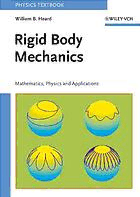
Rigid body mechanics : mathematics, physics and applications PDF
Preview Rigid body mechanics : mathematics, physics and applications
William B. Heard Rigid Body Mechanics William B. Heard Rigid Body Mechanics Math ematics, Physics and Applications WILEY-VCH Verlag GmbH & Co. KGaA The Author All books published by Wiley-VCH are carefully produced. Nevertheless, William B. Heard authors, editors, and publisher do not Alexandria, VA warrant the information contained in USA these books, including this book, to be free of errors. Readers are advised to keep in mind that statements, data, illustrations, procedural details or other items may inadvertently be inaccurate. For a Solutions Manual, lecturers should Library of Congress Card No.: applied for contact the editorial department at [email protected], stating their affiliation and the course in which they British Library Cataloguing-in- wish to use the book Publication Data A catalogue record for this book is available from the British Library. Bibliographic information published by Die Deutsche Bibliothek Die Deutsche Bibliothek lists this publication in the Deutsche Nationalbibliografie; detailed bibliographic data is available in the Internet at <http://dnb.ddb.de>. © 2006 WILEY-VCH Verlag GmbH & Co. KGaA, Weinheim All rights reserved (including those of translation into other languages). No part of this book may be reproduced in any form – by photoprinting, microfilm, or any other means – nor transmitted or translated into a machine language without written permission from the publishers. Registered names, trademarks, etc. used in this book, even when not specifically marked as such, are not to be considered unprotected by law. Printed in the Federal Republic of Germany Printed on acid-free paper Printing betz-druck GmbH, Darmstadt Binding Litges & Dopf Buchbinderei GmbH, Heppenheim ISBN-13: 978-3-527-40620-3 ISBN-10: 3-527-40620-4 Thisbookisdedicatedto Peggy andthememoryofmy MotherandFather VII Contents Preface XI 1 Rotations 1 1.1 RotationsasLinearOperators 1 1.1.1 VectorAlgebra 1 1.1.2 RotationOperatorsonR3 7 1.1.3 RotationsSpecifiedbyAxisandAngle 8 1.1.4 TheCayleyTransform 12 1.1.5 Reflections 13 1.1.6 EulerAngles 15 1.2 Quaternions 17 1.2.1 QuaternionAlgebra 20 1.2.2 QuaternionsasScalar–VectorPairs 21 1.2.3 QuaternionsasMatrices 21 1.2.4 RotationsviaUnitQuaternions 23 1.2.5 CompositionofRotations 25 1.3 ComplexNumbers 29 1.3.1 Cayley–KleinParameters 30 1.3.2 RotationsandtheComplexPlane 31 1.4 Summary 35 1.5 Exercises 37 2 Kinematics,Energy,andMomentum 39 2.1 RigidBodyTransformation 40 2.1.1 ARigidBodyhas6DegreesofFreedom 40 2.1.2 AnyRigidBodyTransformationisComposedofTranslationand Rotation 40 2.1.3 TheRotationisIndependentoftheReferencePoint 41 RigidBodyMechanics:Mathematics,PhysicsandApplications.WilliamB.Heard Copyright©2006WILEY-VCHVerlagGmbH&Co.KGaA,Weinheim ISBN:3-527-40620-4 VIII Contents ( ) 2.1.4 RigidBodyTransformationsFormtheGroupSE 3 41 2.1.5 Chasles’Theorem 42 2.2 AngularVelocity 44 2.2.1 AngularVelocityinEulerAngles 47 2.2.2 AngularVelocityinQuaternions 49 2.2.3 AngularVelocityinCayley–KleinParameters 50 2.3 TheInertiaTensor 50 2.4 AngularMomentum 54 2.5 KineticEnergy 54 2.6 Exercises 57 3 Dynamics 59 3.1 VectorialMechanics 61 3.1.1 TranslationalandRotationalMotion 61 3.1.2 GeneralizedEulerEquations 62 3.2 LagrangianMechanics 68 3.2.1 VariationalMethods 68 3.2.2 NaturalSystemsandConnections 72 3.2.3 Poincaré’sEquations 75 3.3 HamiltonianMechanics 84 3.3.1 MomentaConjugatetoEulerAngles 86 3.3.2 AndoyerVariables 88 3.3.3 Brackets 92 3.4 Exercises 98 4 ConstrainedSystems 99 4.1 Constraints 99 4.2 LagrangeMultipliers 102 4.2.1 UsingProjectionstoEliminatetheMultipliers 103 4.2.2 UsingReductiontoEliminatetheMultipliers 104 4.2.3 UsingConnectionstoEliminatetheMultipliers 107 4.3 Applications 108 4.3.1 SphereRollingonaPlane 108 4.3.2 DiscRollingonaPlane 111 4.3.3 Two-WheeledRobot 114 4.3.4 FreeRotationinTermsofQuaternions 116 4.4 AlternativestoLagrangeMultipliers 117 4.4.1 D’Alembert’sPrinciple 118 4.4.2 EquationsofUdwadiaandKalaba 119 4.5 TheFiberBundleViewpoint 122 4.6 Exercises 127 Contents IX 5 IntegrableSystems 129 5.1 FreeRotation 129 5.1.1 IntegralsofMotion 129 5.1.2 ReductiontoQuadrature 130 5.1.3 FreeRotationinTermsofAndoyerVariables 136 5.1.4 PoinsotConstructionandGeometricPhase 140 5.2 LagrangeTop 145 5.2.1 IntegralsofMotionandReductiontoQuadrature 145 5.2.2 MotionoftheTop’sAxis 147 5.3 TheGyrostat 148 5.3.1 BifurcationofthePhasePortrait 149 5.3.2 ReductiontoQuadrature 150 5.4 KowalevskyTop 153 5.5 LiouvilleToriandLaxEquations 154 5.5.1 LiouvilleTori 155 5.5.2 LaxEquations 156 5.6 Exercises 159 6 NumericalMethods 161 6.1 ClassicalODEIntegrators 161 6.2 SymplecticODEIntegrators 168 6.3 LieGroupMethods 170 6.4 Differential–AlgebraicSystems 179 6.5 WobblestoneCaseStudy 182 6.6 Exercises 187 7 Applications 189 7.1 PrecessionandNutation 189 7.1.1 GravitationalAttraction 190 7.1.2 PrecessionandNutationviaLagrangianMechanics 192 7.1.3 AHamiltonianFormulation 195 7.2 GravityGradientStabilizationofSatellites 197 7.2.1 KinematicsinTermsofYaw-Pitch-Roll 198 7.2.2 RotationEquationsforanAsymmetricSatellite 198 7.2.3 LinearStabilityAnalysis 200 7.3 MotionofaMultibody: ARobotArm 203 7.4 MolecularDynamics 210 X Contents Appendix A SphericalTrigonometry 213 B EllipticFunctions 218 B.1 EllipticFunctionsViatheSimplePendulum 218 B.2 AlgebraicRelationsAmongEllipticFunctions 222 B.3 DifferentialEquationsSatisfiedbyEllipticFunctions 224 B.3.1 TheAdditionFormulas 224 C LieGroupsandLieAlgebras 225 C.1 InfinitesimalGeneratorsofRotations 225 C.2 LieGroups 227 C.2.1 Examples 230 C.3 LieAlgebras 231 C.3.1 Examples 232 C.3.2 AdjointOperators 234 C.4 LieGroup–LieAlgebraRelations 237 C.4.1 TheExpMap 237 ( ) C.4.2 TheDerivativeofexp A t 238 D Notation 241 References 243 Index 247 XI Preface Thisisatextbookonrigidbodymechanicswrittenforgraduateandadvanced undergraduatestudents of science and engineering. The primary reasonfor writing the book was to give an account of the subject which was firmly grounded in both the classical and geometrical foundations of the subject. The book is intended to be accessible to a student who is well prepared in linear algebra and advanced calculus, who has had an introductory course in mechanics and who has a certain degree of mathematical maturity. Any mathematicsneededbeyondthisisincludedinthetext. Chapter1dealswiththerotations,thebasicoperationinrigidbodytheory. Rotationsarepresentedinseveralparameterizationsincludingaxisangle,Eu- lerangle,quaternion,andCayley–Kleinparameters. TherotationsformaLie groupwhichunderliesallofrigidbodymechanics. Chapter 2 studies rigid body motions, angular velocity, and the physical conceptsofangularmomentumandkineticenergy. Thefundamentalideaof angular velocity is straight from the Lie algebra theory. These concepts are illustratedwithseveralexamplesfromphysicsandengineering. Chapter 3 studies rigid body dynamics in vector, Lagrangian, and Hamil- tonian formulations. This chapter introduces many geometric concepts as dynamics occurs on differentialmanifolds and for rigid body mechanics the manifoldisoftenaLiegroup. Theideaoftheadjointactionisseentobebasic totherigidbodyequationsofmotion. Thischaptercontainsmanyexamples fromphysicsandengineering. Chapter 4 considers the dynamics of constrained systems. Here Lagrange multipliers are introduced and several ways of determining or eliminating them are considered. This topic is rich in geometrical interactions and there areseveralexamples,somestandardandsomenot. Chapter5considerstheintegrableproblemsoffreerotation,Lagrange’stop, andthegyrostat. TheKowalevskytopandLaxequationsarealsoconsidered. GeometricaltopicsincludethePoinsotconstruction,thegeometricphase,and RigidBodyMechanics:Mathematics,PhysicsandApplications.WilliamB.Heard Copyright©2006WILEY-VCHVerlagGmbH&Co.KGaA,Weinheim ISBN:3-527-40620-4
